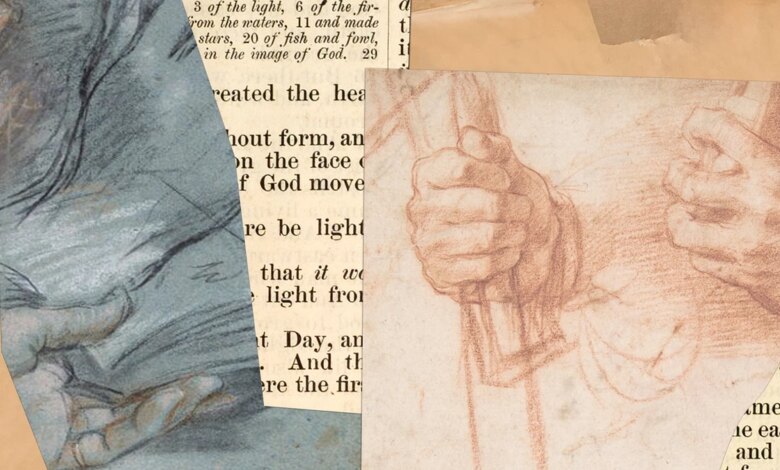The Bible’s Development Is a Messy Story, but It Can Bolster Our Faith

What does history have to do with faith? Everything. As Paul attests in 1 Corinthians 15, Christ died. He was buried. He was raised on the third day. And then “he appeared to Cephas, and then to the Twelve,” and then “to more than five hundred of the brothers and sisters at the same time (vv. 5–6). Because Jesus’ work for his people unfolded on earth for everyone to see, the apostles proclaimed historical events.
What, then, does faith have to do with history? Again, everything. The events proclaimed include the Messiah’s death and resurrection, and faith grasps Jesus’ and the apostles’ interpretation of these events, for Christ died for our sins (1 Cor. 15:3) and was raised for our justification (Rom. 4:25). Christians have long embraced the maxim of “faith seeking understanding,” which entails reasoning and asking questions about the content of our faith, as Augustine explains in his Confessions—but always against a backdrop of ultimate confidence in God and the truths of Scripture.
Susan C. Lim models these habits in her book Light of the World: How Knowing the History of the Bible Illuminates Our Faith. Lim, a Biola University history professor, tells the story of how Scripture came to be, detailing all the twists and turns, all the complex debates and deliberations, that resulted in a settled tradition of which books constitute God’s Holy Word. This story, as she demonstrates, is far from neat and tidy—but understood rightly, can strengthen our trust in both the Bible and God’s sovereign guidance over human affairs. Lim wants her readers to join her in the spirit and faith of the Virgin Mary, asking, “How can this be?” (Luke 1:34, NRSV).
Lim’s book is no mere history of the Bible. Weaving her Christian testimony into chapters on the Bible’s history, her candor is refreshing, even as she shares past doubts and questions leading up to her “second confession” that all the Bible is God’s Word. Not every book recounting the Bible’s history contains a chapter on miracles or even takes up matters of interpretation, archaeological evidence, or the historical reliability of the biblical accounts themselves.
Lim rolls up her sleeves and delves into how the Protestant Bible came to have its 66 books (39 in the Old Testament and 27 in the New Testament). Convinced that knowledge of the Bible’s history can breathe life into our faith, she gives readers the facts, even as she admits that those facts do require interpretation. Lim knows the subject can be contentious, for the evidence sometimes leads down murky paths that don’t always go where we think they should. Many readers will resonate with Lim’s intention and design in this book. I certainly do.
The Old Testament and the Hebrew canon
In this same spirit, then, I want to encourage readers in their study of the history of the Bible as I engage Lim’s book on that subject. In my judgment, the book contains several inaccuracies or outdated theories. A few brief examples will suffice before addressing more significant matters.
Consider, for instance, Lim’s claim that Jerome, the early church priest who translated the Bible into Latin, “perhaps proposed” Ezra as the author of the Pentateuch, or the first five books of the Old Testament. But Jerome, in his treatise Against Jovinianus, comes closer to affirming Moses as the author; in another work, The Perpetual Virginity of Blessed Mary, he merely leaves open the possibility that Ezra restored the Pentateuch rather than writing it. A little later, Lim erroneously claims that the Gospel of Thomas circulated in two versions rather than listing two different literary works (the other is entitled the Infancy Gospel of Thomas).
As an account of the Protestant Bible, Lim narrates the relationship between the Hebrew and Protestant canons. Jews and Protestants have the same contents in what they respectively call the Hebrew Bible and the Old Testament, even though each group numbers, orders, and categorizes the books differently. Regarding whether the Tanakh (an acronym for the three parts of the Hebrew canon) was the Bible that Jesus read, Lim cautiously proposes that it “was considered a tradition by Jesus’ time” and that “we don’t know the definitive answer to this question.” Elsewhere, however, Lim concludes more confidently that the Tanakh “served as the foundation for Jesus’ ministry and the birth of Christianity.”
But the fact is that when Protestants began to list the books of the Old Testament, they did not refer to the Tanakh anywhere. For example, Martin Luther’s Bible (1534) lists the Old Testament contents according to the 24 books of the Hebrew Bible but preserves an order of History, Poetry, and Prophecy. This structure can be traced to early Christians like Gregory of Nazianzus, who lists 22 books, according to the number of letters in the Hebrew alphabet, and divides them into three parts: 12 historical books (like Joshua), 5 poetic books (like Proverbs), and 5 prophetic books (like Isaiah).
The Tanakh, for Lim, aids interpretation of individual books like Esther, since its three-part categorization of Law, Prophets, and Writings provides clues to how early readers interpreted individual books, and her observations on Esther in this regard are noteworthy. Still, she could have guided her readers to other ancient Hebrew canon structures and categories (still visible in most English Bibles today) that could illuminate how early readers interpreted books in light of their placement next to other books.
As readers wade into Light of the World, they will encounter terms and categories that early Christians developed to describe their religious literature. These include homologoumena, or “books unquestionably included in the canon”; antilegomena, referring to books “initially classified as canonical but later disputed”; and pseudepigrapha, books that are “religious in nature but outside the canon.” And a fourth category, the Old Testament Apocrypha, denotes “books added to the Greek Septuagint but never included in the Hebrew Old Testament.”
Researchers now refer to a great number of books (like 1 Enoch) a pseudepigrapha, even though early Christians did not use the term often (Cyril of Jerusalem mentioned “falsely titled” gospels like Thomas) and would have labeled these books as apocryphal or “hidden books.” In the heat of polemic, Jerome once referred to Tobit, Judith, Ecclesiasticus (also known as Ben Sira or Sirach), Wisdom of Solomon, and 1 and 2 Maccabees as “apocrypha.” But elsewhere he recommends these books as edifying reading, albeit not for the sake of confirming church doctrines.
Jerome thus joins other early Christians like Athanasius in describing a middle category of religious literature: neither canonical nor apocryphal, but useful and beneficial. Lim does not mention this middle category, and it leads to a problem as she reconstructs the church fathers’ understanding of how the Bible came to be. Many early Christians may have had a high view of these middle-tier books but would not have described them as canonical, disputed, or apocryphal.
The problem comes to a head in Lim’s discussion of the Septuagint (a Greek book collection notoriously difficult to define) and the Apocrypha. Lim holds that some Jewish scribes were responsible for adding books to the Septuagint that later became known as the Apocrypha. Later, Lim claims “the Apocrypha was appended to the Septuagint, which came to be known as the ‘Alexandrian List.’” This list was compiled in Alexandria, Egypt, even though the Jews never accepted the Apocrypha as canonical. The confusion set in, writes Lim, when some church fathers “misunderstood the Hebrew tradition and regarded some Apocryphal books as canonical.”
The history is messier. There is no evidence that Alexandrian Jews drafted a canon list or that they possessed a different canon than other Jews. This theory has been largely abandoned since the 1960s. Moreover, contrary to what Protestants might expect, many early Christians described the church’s Old Testament canon as agreeing with the Hebrew canon. Slightly later, Christians like Augustine developed a rival tradition based on the idea that the biblical canon encompasses books that the churches read and accepted.
In short, the Protestant Old Testament would come to reflect an early Christian view that limited the Old Testament to the Hebrew canon, while the Roman Catholic Old Testament would reflect another early Christian canon articulated by Augustine and the Synods of Hippo and Carthage. Lim is wrong, then, to state that the 16th-century Council of Trent, the main driver of the Catholic “Counter-Reformation,” was the first to reckon the Apocrypha as canonical. Trent was only the first council to pronounce “anathema” on those who refused to accept its canon.
The fourth century and before
In later sections of the book, Lim navigates similar challenges to the formation of the New Testament canon. Here, we’re introduced to heresies like Gnosticism and Marcionism, along with other early Christian literary works like the Shepherd of Hermas and the Didache. Again, the history behind the formation of the New Testament is messy, but when we grasp it rightly, as Lim contends, we see that God’s sovereignty was never thwarted. Furthermore, Lim believes Christians should take comfort in the fact that the New Testament canon came together in the fourth century and not earlier, since the church fathers were working diligently to distinguish canonical books from other books.
Lim interprets the Roman emperor Constantine’s conversion to Christianity in the fourth century as “pivotal” to the establishment of the church and the confirmation of the New Testament canon. Rightly, she avoids crediting the Council of Nicaea (A.D. 325) with creating the canon, but her emphasis on the council’s debates over orthodoxy and heresy does leave open the question of how those debates related to the New Testament’s formation.
For Lim, the end of the fourth century—the era of the Synods of Hippo (A.D. 393) and Carthage (A.D. 397)—brought about the great achievement of officially recognizing the New Testament canon. And no doubt the fourth century brought clarity to some books like 2 John, 3 John, and 2 Peter, which were not clearly recognized before then.
But Lim’s emphasis on the fourth-century culmination might cause readers to skip over important earlier developments in canon history, like the assembling of the fourfold gospel or the Pauline letters. Around A.D. 250, Origen of Alexandria had already listed the 27 books of the New Testament canon. Thus, the core of the New Testament was already established by the fourth century. Though some point to Athanasius’s 39th festal letter (A.D. 367) as authoritatively defining the New Testament canon, it was only a point of development in this process—not its final resolution.
History is messy because it involves people and materials, and the evidence we possess does not allow us to answer all our questions. But for Lim, the Bible’s history should not occasion despair or the deconstructing of one’s faith. Rather than weakening faith, knowledge of the Bible’s history serves to buttress and strengthen it—and, dare I say, even excite and inspire it. “Faith seeking understanding” commits one to trust God’s good providence even as one’s understanding increases through questioning and interpreting the evidence.
I hope readers of Lim’s book join her in the ever-deepening joy of discovering more of the Bible’s history and how it illuminates the Christian faith. If readers walk away even remotely more confident in the Bible’s trustworthiness and authenticity, and further encouraged on their own faith journeys, then Lim should count her mission successful.
John D. Meade is professor of Old Testament and director of the Text & Canon Institute at Phoenix Seminary. He is coauthor of Scribes & Scripture: The Amazing Story of How We Got the Bible (Crossway).




